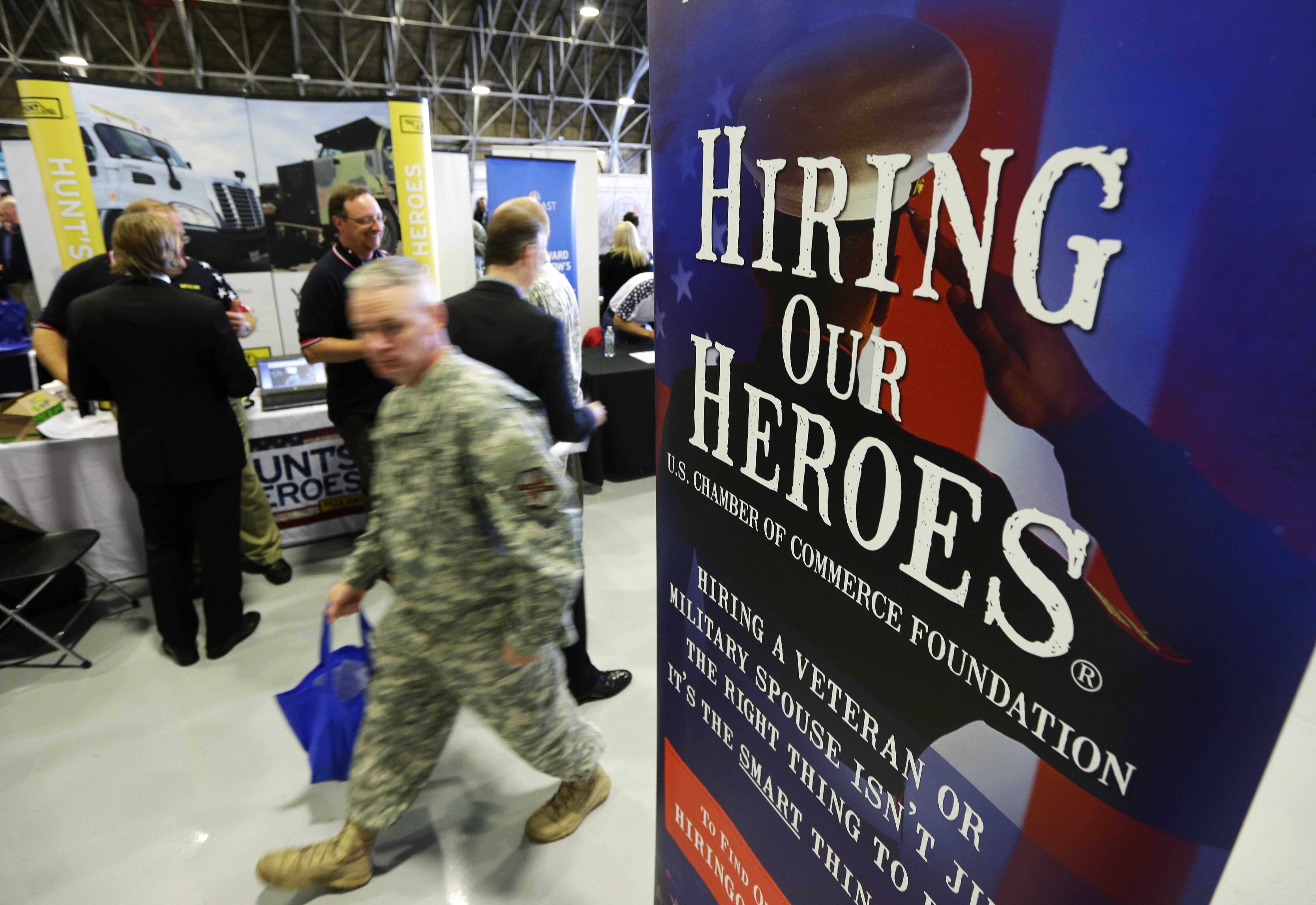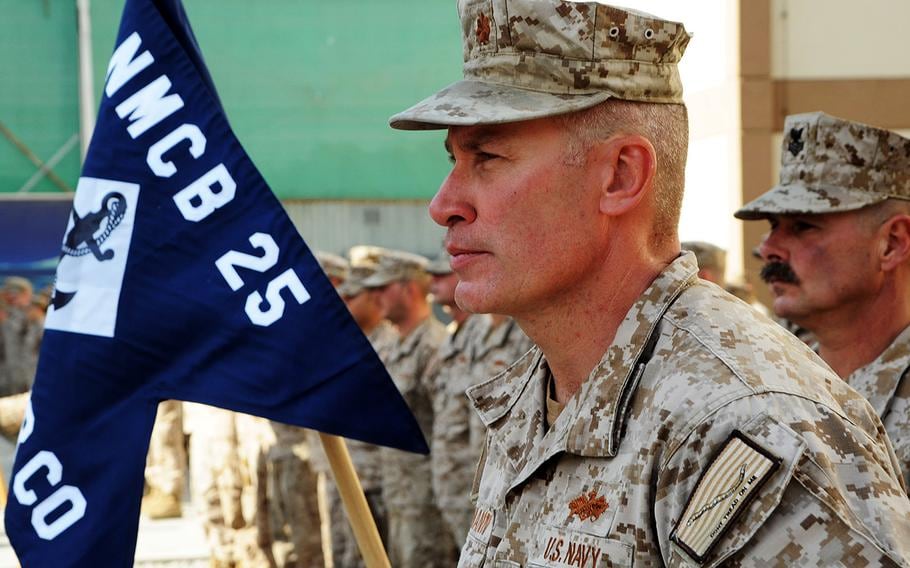NAVAL STATION NORFOLK, Va. – What if sailors could be advanced immediately to openings based on their performance — no test needed — and could broaden their skills across multiple ratings, earning coveted certifications that will better set them up for high-paying jobs after the Navy?
Those are some of the implications of the far-reaching career sea change that the Navy's top enlisted is proposing for enlisted careers in what could become the most radical enlisted personnel overhaul in decades. A system that widens sailors' experience, allows for more predictable advancement and that deep-sixes hidebound career tracks and promotion systems.
The changes are aimed to persuade mid-career sailors like Engineman 1st Class (SW) Mark Santos to stay in. Santos, who only has seven years until earning a Navy retirement, says he's hanging it up — simply because the Navy is holding him back.
After 12 years, Mark Santos is getting out of the Navy, seven years shy of a retirement.
It's not that the surface-warfare qualified,first class engiineman minds going to sea - he plans to keep doing that in civilian life — he simply feels the Navy is holding him back.
"I’m tired of being pigeon-holed as we are in the EN rating," said Santos , who is currently stationed at Norfolk Naval Shipyard told Navy Times in a June 14 interview. "The only place we can go to sea on now are amphib’s, unless we want to be stuck in a carrier reactor department. There just isn’t enough opportunity in the Navy to expand."
Navy enginemen, he continued, aren’t allowed to do related engineering jobs like electrical work or air conditioning and refrigeration repair. Santos says he's planning to get out in August and work for a tug company as a civilian marine engineer to who can do more engineering work and earn Coast Guard certifications.
That's why, Santos, will head to a civilian tug company in August to begin a second career as a civilian marine engineer — where he'll not only be able to use other engineering skills, but also be able to move up by passing Coast Guard certifications.
Losing good sailors because they feel limited isn’t something that sits well with Master Chief Petty Officer of the Navy (AW/NAC) Mike Stevens, who is proposing radical changes to enlisted advancement and careers. The proposal would breakdown the historic rigidity of the Navy's roughly 90 nearly TOTALratings in favor of broadening the sailors' skills and rewarding the best with coveted qualifications and immediate promotion.
"I’m convinced, with the sailors we have today, that these people have a lot more capacity thant we’re using" Stevens told hundreds of sailors at a June 14 all hands call at Naval Station Norfolkthe Norfolk crowd June 14. "Most of you in here can do more than one thing — some of youyou have the skills to go do more things, but it’s in reach of all of you if we provide you the right training at the right time and at the right level."
And with a little more than three months to go with retirement, Stevens is no lame-duck MCPON.
His push takes a page from the small crews of littoral combat ships, where cross-training is essential and sailors are paid for any special pays they qualify for, whether or not they're in that rating. This new direction has emerged out of the controversial gender-neutral review that Stevens has led into job titles.
Stevens detailed the radical new plan for an hour at the all hands call, with many excited about the possibilities. His the Navy is spoke June 14 to a several hundred sailors at the Naval Station, Norfolk base theater. In just under an hour, outlined a radical new plan of personnel initiatives for the enlisted workforce the Navy is now considering, which left many of those listening excited about the possibilities. Theis radical vision: proposes the Navy:
- New advancement system. Scrap the semi-annual advancement exam, replace it with one that ranks Build new advancement system that scraps the advancement exams and instead ranks sailors on their accomplishments and on the job performance. Such a system could advance to vacancy in real time and not require a set, semi-annual cycle and allow sailors to better predict and have more say in when they’ll move up.
- Build your skills. Expand beyond your initial rating to gain skills and specialties that belong to other communities. Encourages sailors to expand beyond their initial ratings and qualify related ratings and skills within their community.
- More choices. Open up detailing to allow These multi-rating qualified Sailors qualified in multiple ratings will be allowed to take orders in any Navy occupation they qualify in — exponentially increasing the number of jobs and duty stations they're eligible for. giving more duty stations and helping the service fully capturing the capabilities in the new billet-based detailing system.
*Design and implement an all new performance evaluation system to support
- Better credentials. Re-align occupations so separating sailors are better prepared for to give sailors better options when they transition to civilian jobs.
The Navy's personnel boss said the recommendations of the second review, ordered in June, are likely to be far reaching.
"As the Navy implements several personnel policy changes as part of our Sailor 2025 program, we expect the results of this review to go well beyond 'new names' for existing rates, and ultimately allow more flexibility in detailing Sailors, provide greater training and credentialing opportunities, and help Sailors become more marketable to civilian employers once they leave the service," Chief of Naval Personnel Vice Adm. Robert Burke said in a statement.
"We envision a point where some combinations of today's rates, with similar training and experience, can quickly and easily cross into the occupations of other similar rates with a limited amount of additional training or experience," Burke continued. "This has the potential to enhance career flexibility and detailing options for our Sailors, while also improving 'fit' — our ability to get the right Sailors with the right skills into the right billets across the Fleet."
'The hardest road'
The idea of this total rework grew out of Navy Secretary Ray Mabus' mandate Secretary of the Navy Ray Mabus gave to the Navy and Marine Corps in January: to Review all the Navy’s job titles and make them gender neutral wherever possible.
Stevens volunteered to lead the effort, saying it was an enlisted issue and his responsibility. Leadership agreed.
He quickly put together a working group of force master chiefs, community experts encompassing every Navy career field.
Stevens brought these leaders to Washington D.C. and told them that this would be a wide-ranging review of the Bringing them first to Washington, Stevens the scope of the review, telling them that everything was on the table. This wasn’t going to be a bandaid fix, it was to be a total review of the Navy’s enlisted occupational structure. He wanted ideas when they returned to Washington on how to to improve the whole tradition-clad system could be better — not just suggestions on removing the word "man" from job titles and rating names. As many as 21 job titles and specialties use the word "man," a holdover that some like Mabus say makes the service less appealing and friendly to women. The review is considering axing some newer titles like aircrew survival equipmentman, as well as timeless ones such as like corpsman and yeoman — even seaman.
"For a week, they worked at that and gave us a whole list of recommendations," Stevens said, who explainedsaid Mabus had opened the door to ideas, no matter how far-reaching they seemed. "Four or five recommendations which turned out to be much like what I have just described to you today."
Mabus, he said, had opened up the door to Stevens without limits, wanting ideas no matter how far fetched they seemed at the time.
"I decided if he was going to open up the door a bit, let’s kick it off the hinges," Stevens said. "This is an opportunity to listen to your sailors and to go out and maybe do something that will eventually put us in a much better place than we are today."
In June, Stevens briefed Mabus, Earlier this month, Stevens, Mabus along with Chief of Naval Operations Adm. John Richardson and new Chief of Naval Personnel Vice Adm. Robert Burke on sat down and discussed these radical ideas. They liked the proposals, and have liked the ideas, Stevens said. A second review is looking at ways to implement these personnel reforms and then to adjust job titles accordingly, a process likely to take a few months.
No final decision were made on what's to happen to rating names, yet, either, because which direction the Navy's leadership decides to take on the radical personnel changes, will determine the options for rating names, too.
"The chief of naval personnel ... , based not that discussion and based on some recommendations we provided him, will soon assemble a working group and by early fall, they’re going to deliver a product that’s going to tell us how we get to the place I just described to you," Stevens said.
If the Navy opts for the changes still taking shape, then it will be months and years to implement them. Stevens said sailors stood to gain a lot. to gain from the path he helped set them on. Stevens told the sailors that it's possible that he’d likely be retired by the time the way forward was decided, but that he’ll be watching from the sidelines.
"Arguably leadership picked the hardest road to start to go down," Stevens said. "But at the end, it’s the option that potentially gives the Navy and it’s sailors the most benefit."
The end of the exam?
All this raises questions about long-standing enlisted advancement rules. But the question is then, Stevens told the crowd, How do you advance such a sailor who is qualified in many different ratings? How to do you evaluate their performance? Even more challenging is how to you evaluate performance of a person like that? He said.
This is a situation similar to that of the littoral combat ship crews, who are often called "hybrid" sailors because the small crew size — roughly 40 in the ship's crew and 25 with the mission package installed — compels them to cross-train and fulfill many different tasks. In many ways, it's a very similar situation to that being encountered by littoral combat ship sailors who have been called "hybrid sailors" and who qualify in different ratings and NEC's. Some of The rules have been changed so for these sailors can that allow them to collect re-up bonuses for any skill they hold, even if what they wear on their sleeve is the wrong rating.
Right now, LCS sailors still advance in their parent rating — as in, the rating that they wear on their sleeve — but Stevens says more far-reaching changes may be warranted. that these are things the working group must wrestle with, but as he told the sailors in Norfolk, most likely they'd have to find another way.
Stevens laid out his vision for a outlined to the sailors a milestones-based system. As it currently stands, a sailor's performance on the latest advancement test is factored into their overall performance and skills, including job evaluations, awards and education. Those scores are then used to rank eligible sailors; personnel officials then advance the sailors according to quotas set by rating.
What if instead, sailors could get advanced anytime there was an opening?
That would mean more opportunity and pay year-round. It would also likely spell the end of the semi-annual advancement exam, which has a section that quizzes takers on their rating knowledge.
"Maybe you go so far as to get rid of the Navy-wide exam because he has all these skills and specialties," Stevens said.
Navy advancement officials always say that the reason for only purpose for the semi-annual advancement exam system is to rank order sailors based on their knowledge level, which results in changing rankings for eligible sailors twice a year.
Stevens said the Navy could set up a continuous rank order, based on factors like qualifications evaluations and time in grade. This would allow a sailor to So, Stevens said. what if there was a continuous rank order of each rating and paygrade, where sailors always know where they stand against their peers — and to work harder to move up.
t that would take into account time in grade and service as well as the qualifications and certifications the sailor had wracked up.
"What if we had a promotion system in place that with all these skill sets, and a given time in grade that we're going to promote you to first class petty officer?" Stevens proposed to the crowd. "What if there was a system like that where promotion was predictable?"
The CNO and Stevens have said that one consistent message from sailors is their demand for more And that's the goal, from CNO Richardson down to Stevens because one thing they hear from sailors is that they want predictable advancement. They'd know where they stand and work harder to gain more points to move themselves up the list. Things like qualifications, certifications and qualifying in other ratings and performance evaluations could be given point values. With a continuous list, sailors could advance year-round as vacancies occur.
Officials are still trying to work through how the service would rank sailors who hold multiple ratings, in a way that rewards them for their broader skills rather than penalize them against more specialized peers who only work in their rating.
Another thing that must be on the table then, is the Navy's evaluation process to measure a sailor's job performance over a set amount of time.
But one thing is also clear to Stevens and that any new personnel system will need a performance evaluation process that fits it.
"If we go to a system like this, the evaluation system we have today won't work," he saidtold the sailors. "We'll be forced to look at something else, some other kind of performance evaluation to align ourselves better this potentially new personnel system we're talking about."
To be sure, the changes that MCPON envisions are for more senior sailors, who already know their rating well and are broadening to other fields.And, he said, this wouldn't be for raw recruits.
"I don't think you'll see this in a first enlistment," he said. "You'll come in and learn a particular occupational specialty, then, if you showed the capacity to expand, you'll go from there."
Again, he said, fleshing out the basic idea will to this initial working group to brainstorm the way forward.
What's next
Stevens is proposing a sea change in enlisted careers. It will fall to the next working group to figure out whether they're feasible. Stevens says the ideas he's presenting are the shell of an idea that would have to be fleshed out and developed. That's what the working group being set up will initially do. And then those recommendations will be reviewed by a devil's advocate One that's done, Stevens said, their recommendations must be looked at by a devils' advocate — a "red cell" in Stevens' words called it — to find all the holes in the plan.
That task is likely to take months as the Navy first searches for and then progressively implements a scheme better than the But, before before anything would replace the existing personnel system, a new one must be found to be just as good as the one it's replacing.
Stevens estimates that shifting to a new system like this would take at least three What is clear, Stevens said is the Navy is willing to look at such deep fundamental change and what it would take to realize it. Should the Navy elect to go down this path, it would be a minimum of 3 to five years before they could field a totally new system like this.
Still, from Secretary Mabus on down, though, Navy leadership is ready and willing to deep look at the possibilities as they look towards the future and the desire to attract and retain the best and brightest new recruits.
In fact, not all ratings will fit into this mold today, and some will would have to be reworked to suit it. One examples here is hospital corpsman, the largest rating in the Navy at nearly 25,000 strong. But within the corpsman rating are many, many specialties, currently identified by Navy Enlisted Classifications. Potentially, These sailors could seek to diversify more within their own rating.
"Not everybody will be able to do this," Stevens cautioned. "We can't have people that only have a fundamental idea of what they're doing — we need people that are somewhat experts in their field."
"But wherever we can, there's opportunity in all this, in some of our ratings and some of our fields, to provide sailors with more opportunity to expand and grow should they show the capacity."
As far as EN1 Santos, would all of this change persuade him to re-up? And what about EN1 Santos would Stevens presentation change his mind?
"If this system were up and running right now, I'd probably stay in," he said. "But as it is, I'm still on my way out."
Mark D. Faram is a former reporter for Navy Times. He was a senior writer covering personnel, cultural and historical issues. A nine-year active duty Navy veteran, Faram served from 1978 to 1987 as a Navy Diver and photographer.





